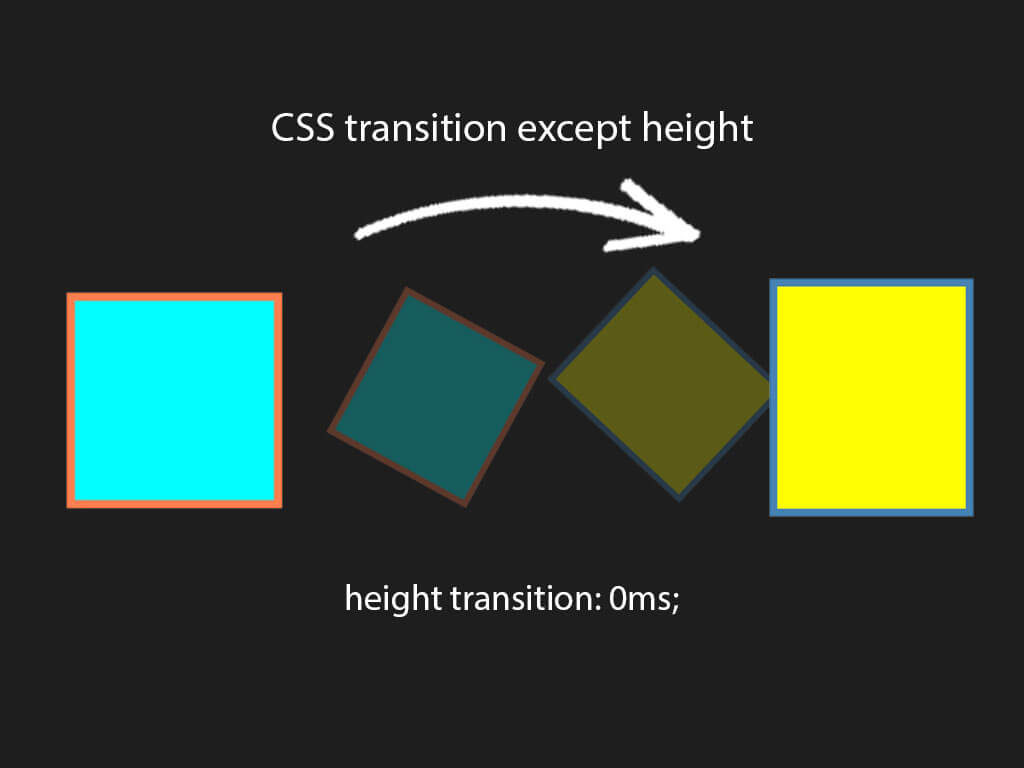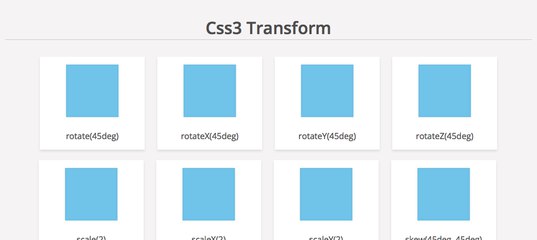Плавные переходы : Transition : CSS-анимационные изменения состояния
Создавайте плавные переходы между двумя состояниями при наведении на элемент. UIkit 3 и Transition. Руководство по использованию.
Руководство по использованию Transition
Чтобы переключить переход при наведении или фокусе, добавьте класс .uk-transition-toggle в родительский элемент. Также добавьте tabindex="0" чтобы сделать анимацию фокусируемой с помощью клавиатуры и сенсорных устройств. Добавьте один из классов .uk-transition-* к любому дочернему элементу, чтобы применить фактический эффект.
| Класс | Описание |
|---|---|
.uk-transition-fade |
Позволяет элементу плавно появляться и исчезать. |
.uk-transition-scale-down |
Элемент масштабируясь увеличивается или уменьшается. |
.uk-transition-slide-top.uk-transition-slide-bottom.uk-transition-slide-left.uk-transition-slide-right |
Позволяет элементу скользить сверху, снизу, слева, справа. |
.uk-transition-slide-top-small.uk-transition-slide-bottom-small.uk-transition-slide-left-small.uk-transition-slide-right-small |
Элемент скользит сверху, слева или справа с маленького расстояния. |
.uk-transition-slide-top-medium.uk-transition-slide-bottom-medium.uk-transition-slide-left-medium. |
Элемент скользит сверху, снизу, слева или справа на среднем расстоянии. |
Компонент Плавные переходы
<div tabindex="0">
<div></div>
</div>
- Результат
- Разметка
Fade
Fade
Bottom
Bottom
Иконка
2 Изображения
Изображение масштабируется (Scale Up)
Заголовок
Подзаголовок
Текст (Small Top + Small Bottom)
<div uk-grid> <div> <div tabindex="0"> <img src="/demo/img/dark. jpg" alt="Transition">
<div>
<p>Fade</p>
</div>
</div>
<p>Fade</p>
</div>
<div>
<div tabindex="0">
<img src="/demo/img/dark.jpg" alt="Transition">
<div>
<p>Bottom</p>
</div>
</div>
<p>Bottom</p>
</div>
<div>
<div tabindex="0">
<img src="/demo/img/dark.jpg" alt="Transition">
<div>
<span uk-icon="icon: plus; ratio: 2"></span>
</div>
</div>
<p>Иконка</p>
</div>
<div>
<div tabindex="0">
<img src="/demo/img/dark.jpg" alt="Transition">
<img src="/demo/img/light.
jpg" alt="Transition">
<div>
<p>Fade</p>
</div>
</div>
<p>Fade</p>
</div>
<div>
<div tabindex="0">
<img src="/demo/img/dark.jpg" alt="Transition">
<div>
<p>Bottom</p>
</div>
</div>
<p>Bottom</p>
</div>
<div>
<div tabindex="0">
<img src="/demo/img/dark.jpg" alt="Transition">
<div>
<span uk-icon="icon: plus; ratio: 2"></span>
</div>
</div>
<p>Иконка</p>
</div>
<div>
<div tabindex="0">
<img src="/demo/img/dark.jpg" alt="Transition">
<img src="/demo/img/light.
Компоненты UIkit 3
Financing Energy Transition in Developing Countries
This page in:
This page in: English
- Español
- العربية
- Русский
WASHINGTON, April 20, 2023 — Energy transition in developing countries will require an unprecedented transformation of the power sector infrastructure, with scaling up of energy efficiency and renewable energy as well as a phasing down of coal-fired power generation.
Without the means to fund an energy transition and network infrastructure, developing countries often pay more for electricity; they cannot access energy efficiency or renewable energy projects, and are locked into fossil fuel projects with high and volatile costs. In essence, they face a triple penalty for their energy transition that becomes a poverty trap.
World Bank Group estimates that low- and middle-income countries host 89 percent of the approximately $1 trillion in global coal-fired power generation at risk of being stranded. To fund a just power transition will require much higher capital flows than are being mobilized today in order to meet the growth needed in lower carbon electricity production.
“Accelerating the energy transition toward lower carbon sources while providing reliable access to electricity for businesses and people will require verifiable emission reduction financing, close partnership with the private sector, and significantly higher funding, especially concessional resources,” said World Bank Group President David Malpass.
“Scaling Up to Phase Down” sets out the challenges facing developing countries seeking to transition their power sectors, in order to identify pathways to address these issues. Three key barriers prevent developing countries from accelerating their energy transition. First, renewable energy projects entail prohibitively high upfront capital costs, and many countries lock themselves into costly and high carbon energy choices with inefficient energy subsidies. Second, developing countries face a high cost of capital that distorts their investment choices away from renewables. And third, weak energy sector fundamentals—especially institutional capacities—hinder the scaling of the transition.
The framework distils the energy transition into a “virtuous cycle” of six steps that are foundational for overcoming barriers to renewable energy. The cycle starts with government leadership, which is translated to a supportive regulatory environment, increasingly capable institutions, and instruments to minimize risks, followed by transparent and competitive project allocation, which can deliver renewable energy that serves urgent needs, including energy security, energy affordability, and jobs.
The cycle starts with government leadership, which is translated to a supportive regulatory environment, increasingly capable institutions, and instruments to minimize risks, followed by transparent and competitive project allocation, which can deliver renewable energy that serves urgent needs, including energy security, energy affordability, and jobs.
“Widespread energy transformation in developing countries requires continuous, strategic engagement and far more coordination among governments, investors, and partners than exists presently,” said Guangzhe Chen, World Bank Vice President for Infrastructure. “The World Bank can play a vital role in getting the virtuous cycle started through supporting governments with low-cost and concessional climate finance for transition preparation, utility and network strengthening, and funding affordable clean energy investments.”
The “ Scaling Up to Phase Down” approach also offers solutions for the politically and financially complex challenge of phasing out coal-fired power. Deeper planning can help mitigate stranded asset risks. Refinancing of coal plant liabilities can move retirement dates forward. Workers and communities that base their livelihoods on the coal economy must be ensured a just transition. Concessional support is needed to help countries capture more of the global benefits associated with coal phase down as a global public good.
Deeper planning can help mitigate stranded asset risks. Refinancing of coal plant liabilities can move retirement dates forward. Workers and communities that base their livelihoods on the coal economy must be ensured a just transition. Concessional support is needed to help countries capture more of the global benefits associated with coal phase down as a global public good.
PRESS RELEASE NO: 2023/070/EEX
Blogs
WHAT’S NEW
Scale — Tailwind CSS
Основное использование
Масштабирование элемента
утилиты для масштабировать элемент.<изображение> <изображение>![]()
Использование отрицательных значений
Чтобы использовать отрицательное значение шкалы, поставьте перед именем класса дефис, чтобы преобразовать его в отрицательное значение.
Удаление преобразований
Чтобы удалить сразу все преобразования элемента, используйте утилиту transform-none :
Это может быть полезно, если вы хотите удалить преобразования по условию, например, при наведении или в определенной точке останова.
Аппаратное ускорение
Если ваш переход работает лучше при рендеринге с помощью графического процессора, а не центрального процессора, вы можете принудительно использовать аппаратное ускорение, добавив transform-gpu утилита:
Используйте transform-cpu для принудительного возврата к ЦП, если вам нужно отменить это условно.
Условное применение
Наведение, фокус и другие состояния
Tailwind позволяет вам условно применять служебные классы в различных состояниях, используя модификаторы вариантов. Например, используйте hover:scale-125 , чтобы применять утилиту scale-125 только при наведении.
<дел>

 uk-transition-slide-right-medium
uk-transition-slide-right-medium jpg" alt="Transition">
<div>
<p>Fade</p>
</div>
</div>
<p>Fade</p>
</div>
<div>
<div tabindex="0">
<img src="/demo/img/dark.jpg" alt="Transition">
<div>
<p>Bottom</p>
</div>
</div>
<p>Bottom</p>
</div>
<div>
<div tabindex="0">
<img src="/demo/img/dark.jpg" alt="Transition">
<div>
<span uk-icon="icon: plus; ratio: 2"></span>
</div>
</div>
<p>Иконка</p>
</div>
<div>
<div tabindex="0">
<img src="/demo/img/dark.jpg" alt="Transition">
<img src="/demo/img/light.
jpg" alt="Transition">
<div>
<p>Fade</p>
</div>
</div>
<p>Fade</p>
</div>
<div>
<div tabindex="0">
<img src="/demo/img/dark.jpg" alt="Transition">
<div>
<p>Bottom</p>
</div>
</div>
<p>Bottom</p>
</div>
<div>
<div tabindex="0">
<img src="/demo/img/dark.jpg" alt="Transition">
<div>
<span uk-icon="icon: plus; ratio: 2"></span>
</div>
</div>
<p>Иконка</p>
</div>
<div>
<div tabindex="0">
<img src="/demo/img/dark.jpg" alt="Transition">
<img src="/demo/img/light.
 в документации Hover, Focus и других состояний.
в документации Hover, Focus и других состояний. js
js



